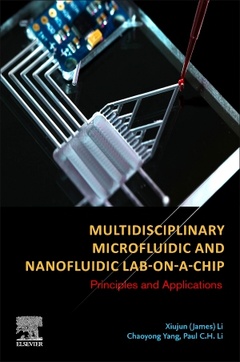Multidisciplinary Microfluidic and Nanofluidic Lab-on-a-Chip Principles and Applications
Coordonnateurs : Li Xiujun (James), Yang Chaoyong, Li Paul C. H.

Multidisciplinary Microfluidic and Nanofluidic Lab-on-a-Chip: Principles and Applications provides chemists, biophysicists, engineers, life scientists, biotechnologists, and pharmaceutical scientists with the principles behind the design, manufacture, and testing of life sciences microfluidic systems. This book serves as a reference for technologies and applications in multidisciplinary areas, with an emphasis on quickly developing or new emerging areas, including digital microfluidics, nanofluidics, papers-based microfluidics, and cell biology. The book offers practical guidance on how to design, analyze, fabricate, and test microfluidic devices and systems for a wide variety of applications including separations, disease detection, cellular analysis, DNA analysis, proteomics, and drug delivery.
Calculations, solved problems, data tables, and design rules are provided to help researchers understand microfluidic basic theory and principles and apply this knowledge to their own unique designs. Recent advances in microfluidics and microsystems for life sciences are impacting chemistry, biophysics, molecular, cell biology, and medicine for applications that include DNA analysis, drug discovery, disease research, and biofluid and environmental monitoring.
Part I: Fundamentals of microfluidic/nanofluidic lab-on-a-chip1. Micromachining Methods2. Micromachining of silicon, glass devices3. Micromachining of polymers4. Fabrication of paper-based microfluidic devices5. Biocompatibility and surface modifications6. Systems interconnect and world-to-chip interface7. Microfluidic Flow control
Part II: New Emerging Techniques8. Droplet microfluidics9. Closed-channel Droplet generation10. Open-format Digital microfluidics11. Nanofluidics12. Nanofabrication13. Characteristics of nanofluidics
Part III: Applications14. Applications to Cell Biology15. Manipulation of cells 16. Cellular measurements and analysis17. Single-cell analysis18. 3D cell culture19. Organs-on-a-chip20. Applications to Nuclei Aids Analysis21. Nucleic acids extraction and purification22. Nucleic acids amplification23. Forensic DNA typing24. Microarray DNA chips25. Applications to proteins analysis26. Immunoassay27. Protein separation28. Enzymatic analysis29. Proteomics30. Applications to global health31. Low-cost Paper-based diagnosis devices32. Field diagnosis33. Other applications43. Environmental analysis44. Forensic analysis45. Small ions and molecules analysis46. Microreacter47. Perspective48. Instrument/device commercialization
Dr. Chaoyong Yang received his PhD from University of Florida in 2006 under the guidance of Professor Weihong Tan. He joined Professor Richard Mathies’ group a
- Provides calculations, solved problems, data tables and design rules to help understand microfluidic basic theory and principles
- Gives an applied understanding of the principles behind the design, manufacture, and testing of microfluidic systems
- Emphasizes on quickly developing and emerging areas, including digital microfluidics, nanofluidics, papers-based microfluidics, and cell biology
Date de parution : 09-2021
Ouvrage de 484 p.
19x23.3 cm
Thèmes de Multidisciplinary Microfluidic and Nanofluidic Lab-on-a-Chip :
Mots-clés :
3D printing; Acoustic tweezers; Acoustics; Acoustofluidics; Amplification free; Animal model; Application; Biomedical application; Biomedicine; CFD; Cancer biology; Capillary; Cell analysis; Cell manipulation; Cell separation; Cell treatment; Chemistry; Detector; Disease biomarkers; Droplet microfluidics; Drug development; Drug discovery; Electrokinetic injection; Energy harvesting; µCEC; µCZE; µIEF; µMEKC; Floating mode; Flow sensing; Gated mode; Hybrid devices; Hybridization; Hydrodynamic injection; Immunoassay; Integration; Interface; Isothermal amplification; Lab-on-a-chip; Low cost; Magnetic particles; Micro-electro-mechanical systems (MEMS); Microchip CITP; Microchip capillary electrophoresis; Microchip capillary gel electrophoresis; Microchip two-dimensional electrophoresis; Microfluid and nanofluidics; Microfluidic chip; Microfluidic chips; Microfluidic platform; Microfluidics; Microfluidics nozzle; Microscale reactors; Modular microfluidics; Nano-in-nano integration; Nanofluidics; Nanomaterials; Natural convection; Nucleic acid detection; Nucleic acid test; Organ-on-a-chip; Paper-based microfluidics; Pharmaceutical analysis; Pinched mode; Point-of-care detection; Polymerase chain reaction (PCR); Protein analysis; Protein separation; Rapid disease diagnostics; Redox MHD; Reproducing organ functions; Self-powered devices; Separation resolution; Separation speed; Single molecule studies; Single nucleotide polymorphism; Soft photolithography; Spreading; Surface; Synthesis; Thermoplastic polymer (hydrogels or paper)–based microfluidics; Triboelectric nanogenerator; Wetting; µCEC; µCZE; µIEF; µMEKC


